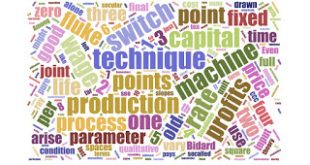"In that early and rude state of society which precedes both the accumulation of stock and the appropriation of land, the proportion between the quantities of labour necessary for acquiring different objects seems to be the only circumstance which can afford any rule for exchanging them for one another. If among a nation of hunters, for example, it usually costs twice the labour to kill a beaver which it does to kill a deer, one beaver should naturally exchange for or be worth two deer....
Read More »Richard Wolff Versus Steven (“Destiny”) Bonnell
[embedded content]A Debate on Socialism versus Capitalism I suppose Destiny entered this debate in good faith. But why did he have to lie about what Wolff was saying? Wolff certainly never repudiated the labor theory of value in his opening remarks. And later Wolff explicitly argued that the Democrats are not socialist. One may not understand or agree with Wolff, but why lie? Apparently "Destiny" feels he lost badly and has been trying to find somebody less eminent to contrast his...
Read More »Brad DeLong, Noah Smith, And Others On The Cambridge Capital Controversy
Brad DeLong and Noah Smith chat about the Cambridge Capital Controversy on their podcast, Hexapodia is the key insight. Noah says it was only mentioned in one of his classes on macroeconomics, but seems to say he was never formally taught it. Given his summary near the start of this discussion, he has obviously read something about it. Brad thinks the language used by the MIT economists in the 1960s was badly and inaccurately phrased and poorly suited to shed light. He says he had trouble...
Read More »Paul Krugman Ignorant Of The Cambridge Capital Controversy
Zach Carter has an appreciation of Joan Robinson's work on imperfect competition, with a bit about the role of Cambridge circus in helping Keynes write the General Theory. Paul Krugman, gatekeeper, reacts: "Nice appreciaton of Joan Robinson, although no mention of her later role. Sad to say, as a student I mainly encountered her through the 'Cambridge capital controversy', a huge intellectual muddle. Somehow Robinson and others managed to convince themselves that the moral legitimancy of...
Read More »Two Four-Technique Patterns With Markup Pricing
Figure 1: Wage Curves for the Example1.0 Introduction The Cambridge Capital Controversy (CCC) applies to models both of competitive industries and of non-competitive industries. Around a switch point exhibiting capital-reversing, a higher wage is associated with greater employment per unit of net output produced. It is not merely a question of what technology is available. It is also a matter of the power of firms among industries to extract value from their workers, their upstream...
Read More »Fluke Switch Points in Pure Fixed Capital Systems
I have a working paper at the Centro Sraffa. Abstract: This article considers structural economic dynamics, in models with fixed capital and a choice of technique, of the production of commodities. Fluke switch points are described and cataloged. For fluke switch points, parameter perturbations create a qualitative change in how the choice of technique varies with distribution. Techniques are presented for visualizing partitions of parameter spaces such that the analysis of the choice of...
Read More »Algebraic Geometry
[embedded content]An Introduction to Algebraic Geometry I have been looking for fluke switch points in certain parameter spaces of coefficients for polynomial equations. Bertram Schefold has pointed out to me that I may want to look into algebraic geometry. This may be beyond me. I consider what I have been doing as exploratory mathematics, and I have been relying on numerical algorithms. I started with thinking that there is a parallel to bifurcation theory. But Barkley Rosser convinced me...
Read More »Flummery From Robert A. Heinlein
He had been droning along about 'value,' comparing the Marxist theory with the orthodox 'use' theory. Mr. Dubois had said, 'Of course, the Marxian definition of value is ridiculous. All the work one cares to add will not turn a mud pie into an apple tart; it remains a mud pie, value zero. By corollary, unskillful work can easily subtract value; an untalented cook can turn wholesome dough and fresh green apples, valuable already, into an inedible mess, value zero. Conversely, a great chef...
Read More »Elsewhere
[embedded content]The Banach-Tarski ParadoxThe Hahn-Banach theorem is related to how mainstream economics model perfect competition. The video above is mind-bending math. The Mountain Goat blog. A profile of some economists at Berkeley, some of who I have read when they collaborated with Thomas Piketty or A. Dube. I have read deLong, as well, of course. If you cannot name 'capitalism', 'neoliberalism', or 'neoclassical economics', it is difficult to criticize them. Here is a popular...
Read More »The Production Function In A Discrete Technology
Figure 1: Isoquants For The Production Function1.0 Introduction I often assume a discrete technology in my demonstrations that what many mainstream economists teach is mostly incoherent balderdash. Some incompetents have told me that such well-established results "just show that the particular production functions that you have chosen don't work. This is not a generic result." So, for my amusement, I will go through a simple example here to explain how any continuously differentiable...
Read More » Heterodox
Heterodox



